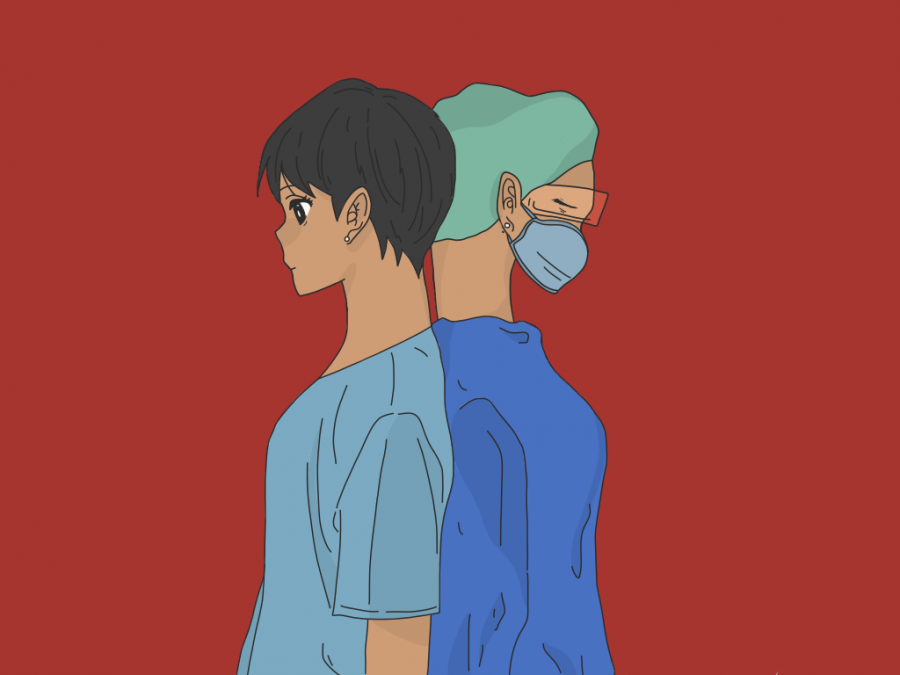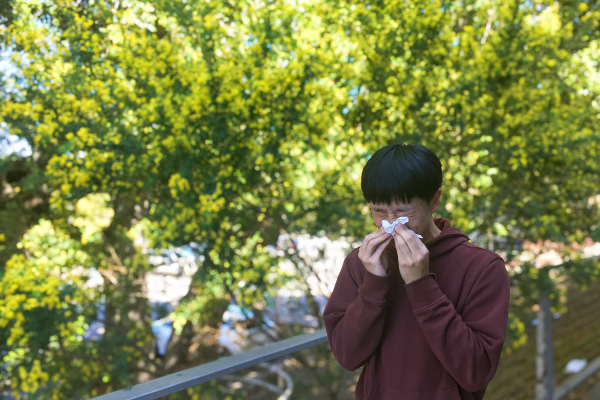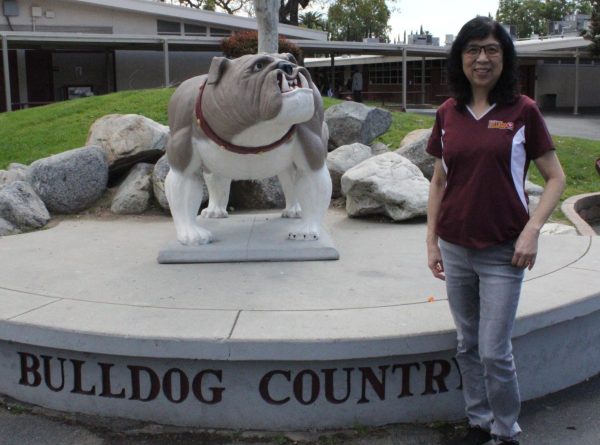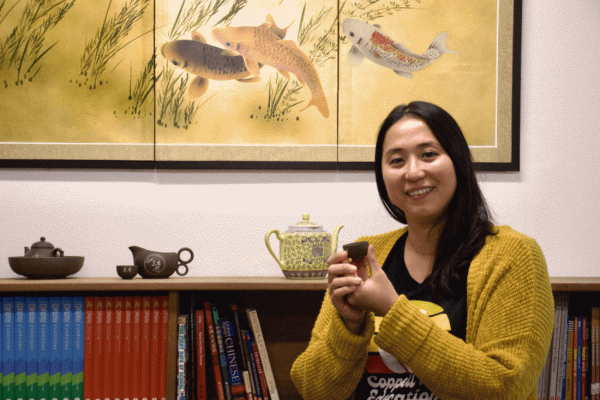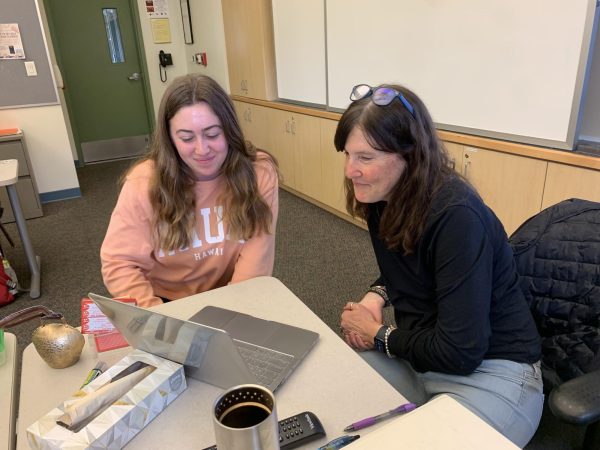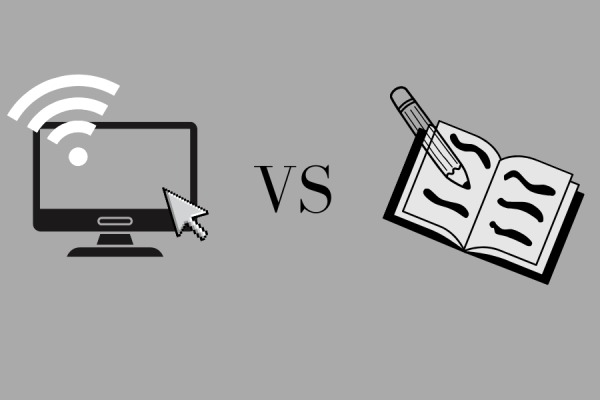One Year Later
March 23, 2021
The cancellation of concerts, clubs, and competitions. The paranoia of communication. The excitement of a continuous spring break. As the two-week spring break turned into a one-year remote experience, all was changed.
In the past year, students and teachers have gone through many academic changes, sports have been postponed, canceled, and rescheduled, and the world was turned upside down. Now, as pandemic living has become the new normal, the changes from March 13, 2020 to March 13, 2021 seem more drastic.
COVID-19 brings mourning to families
News and media outlets mentioned a virus spreading across China with images and videos of emergency rooms filled at capacity and infected individuals with ventilators. Never did anyone realize that the same fate would be for the United States on March 13, 2020.
The start of this upcoming national shutdown originated in Washington. According to the New England Journal of Medicine, in January 2020, a 35-year-old man headed to urgent care in Washington with symptoms of a cough and fever. He told health care workers that he had visited family in Wuhan, China and traveled back to Washington on Jan. 15, 2020. He saw a health alert from the Centers for Disease Control and Prevention about the coronavirus outbreak in China. Due to his current symptoms, he decided to seek help from health care providers. The patient was diagnosed positive for SARS-COV-2, which would later be commonly known as COVID-19.
In Europe, COVID-19 cases were increasing rapidly. Shortly after, countries in Europe went into lockdown. Former President of the United States, Donald Trump, announced a ban on travel from Europe for 30 days due to the accelerating cases. Despite the travel restrictions, the cases in the U.S. began to multiply.
On March 11, 2020, the World Health Organization declared the coronavirus a pandemic. Director-General of the World Health Organization, Tedros Adhanom Ghebreyesus, spoke out about the increasing number of COVID-19 cases.
If you don’t want to do it for you, do it for your family. I would never wish anyone to go through what I went through these past six months. Do not be selfish, think about others, and do your part to help stop the spread.
— Mary Ananya
“We have never before seen a pandemic sparked by a coronavirus,” Ghebreyesus said. “This is the first pandemic caused by a coronavirus, and we have never before seen a pandemic that can be controlled, at the same time.”
On March 12, there were more than 2,000 cases in the U.S., and on Friday, March 13, Trump declared a national emergency to prevent a wider outbreak of COVID-19. That same Friday, District 204 along with other educational institutions such as Illinois State University and Northwestern University canceled in-person classes. The change to remote learning would soon be the new normal for students.
“Since I knew little information about the virus, I didn’t think much of it, and it never occurred to me how bad things would get all over the world,” junior Mary Anaya said.
With the cases in Illinois rising to 585 on March 20, Governor J.B. Pritzker announced a stay-at-home order until April 7. As more people were staying indoors, news outlets were updating the public every day with more information. The scenes in New York City showed a shortage of nurses, and hospital equipment was not enough for all the incoming patients. Nurses all across the U.S. were contacted to help in New York.
Throughout the summer of 2020, COVID-19 testing locations become more accessible. With the number of increasing positive cases, the COVID-19 vaccine became a priority to protect those who are more susceptible and exposed like healthcare workers and frontline workers.
On July 27, Moderna, a pharmaceutical and biotechnology company, was funded $472 million by the Trump administration to expand their vaccine trial to 30,000 participants. This brought the total investment to $955 million.
The news about a vaccine brought hope to all those who have been affected by the pandemic, such as healthcare workers, frontline workers, teachers, and more. The mental health of many was also at risk.
“I flew to San Diego by myself for two weeks to take a break from my home life,” Anaya said. “When I came back, my nightmare became reality. It turns out that I had the virus and spread it to my family, and it hit my dad the most.”
The pandemic had a different impact on everyone. In times of crisis, affected people like Anaya found her comfort in her family and friends.
“He suffered for over a month in the hospital until he passed away on Sept. 3,” Anaya said. “I lost one of my biggest supporters, a role model, so of course that has affected me, especially because I felt so responsible. It’ll affect me for the rest of my life. Thank God I had my family and friends to fall back on, or who knows where I would be today.”
On Nov. 19, Edward-Elmhurst Health held a virtual town hall meeting to update how its hospitals have dealt with the pandemic. Elmhurst Mayor, Steve Morley, acknowledged the months of restless work coming from healthcare workers.
“This is the new norm for them,” Morley said. “I do not know how they do it, but they are doing it and it is a testament to the support that they have. They may have COVID-19 fatigue, and you see that behind the curtains, but we don’t see it as patients.”
On Dec. 10, the FDA approved the first COVID-19 vaccine by Pfizer, BioNTech, which allowed shipments to begin. Healthcare workers and those more susceptible to COVID-19 were vaccinated within days. A week after, on Dec. 17, the FDA endorsed the Moderna COVID-19 vaccine and started shipments as well.
With the vaccine, individuals were more comfortable with leaving their homes as the Pfizer, BioNTech vaccine demonstrated to be 95% effective against COVID-19. Within the next few months, essential workers and teachers were vaccinated. The vaccination of teachers allowed schools to reopen for hybrid learning. Students were able to go back to in-person classes after a semester of full remote learning. On Jan. 25, 2021, District 204 began its return to school plan. Students who chose to come back to hybrid learning were instructed to follow all COVID-19 safety precautions.
The year introduced challenges to education as well as economical hardships. After almost a year of isolation from others, economic issues arose throughout the country.
President of the United States Joe Biden signed the COVID-19 relief bill which will help families who have struggled financially. On March 11, 2021, President Biden signed a $1.9 trillion COVID-19 relief bill that will fund vaccine distribution, $1,400 cash payments to Americans, and support for nutrition programs, health care, and pensions.
Since March 13, the country has experienced the drastic effects of the pandemic. The CDC continues to provide new information to the public every day and enforce safety guidelines to reduce transmission.
“If you don’t want to do it for you, do it for your family,” Anaya said. “I would never wish anyone to go through what I went through these past six months. Do not be selfish, think about others, and do your part to help stop the spread.”
Metea sports face frequent changes
The fateful day of March 13 was an unexpected turning point for all District 204 students. That Friday would be the first of roughly 150 days without high school sports. Spring teams were hit the hardest because of the confusion and the mass amount of rumors that spread. One rumor that did spread around was the possibility of a season during the summer months. The rumor eventually was shut down after IHSA confirmed there would be no sports for the remainder of the school year.
The exponential rise in COVID-19 cases that hit Illinois shut down the state. It was only a matter of time before a student-athlete was going to be diagnosed with the virus, but there was still not much known about COVID-19. The uncertainty of the disease mixed with the increasing numbers was an unforeseen disaster.
“No one really understood much about COVID-19,” Athletic Director Matthew Fehrmann said. ”It would have been tough to allow some sports without guidelines or professional opinion to be shared on how to safely operate. I have never been a part of a pandemic before, but what I can say is that you really do not want to rush into things without fully understanding what or how to handle it or how to move forward.”
This plan, like nearly every aspect of our current lives, remains fluid.
— Craig Anderson
After springtime concluded, the opportunity of sports for next year was the main focus for the IHSA. The IHSA board was eager to get some sort of season in place before the start of the new school year. Executive Director Craig Anderson and the rest of the IHSA Board set off on a mission to do just that.
On Wednesday, July 29, Anderson announced that the board had released a schedule for all the seasons and that the plan was sent to the Illinois Department of Health for evaluation. The seasons were originally divided up into the usual fall, spring, winter, and summer, but the biggest change came from the length of the seasons. The lack of opponents Metea could face grew from years past. This came to be because the Mustangs and other surrounding schools were only allowed to play schools that were close in proximity.
The athletes and coaches that participated in the fall season were the trailblazers in the new sets of shortened seasons. Pritzker’s mask mandate and the several rules and regulations that he added changed the dynamic of the team.
“The main thing [that was] affected was the team environment,” Junior Sydney Lewis said. “We were allowed to ride the bus to practice or meets. We were not allowed to have tournaments and give each other high fives and fist bumps like normal.”
The original schedule came to a screeching halt when on Nov. 17, right before games would start for the winter season, Governor J.B. Pritzker announced that sports would be stuck on another pause after the recent increase in cases. Anderson was prepared for this moment; his scheduling back in July was purposely made to be changed in case there was a need to do so.
“This plan, like nearly every aspect of our current lives, remains fluid,” Anderson said. “Changes may come, and if they do, we will be agile while putting safety and students first. It was important that we provide a framework today for our student-athletes, coaches, administrators, and officials to begin preparing for the 2020-21 school year.”
Anderson still had one problem to face before he and the board could get a new schedule passed. Pritzker was stern on no sports at the time, but that did not fly with IHSA. In the weeks to follow, both sides would keep their stance on the issue, but Pritzker prevailed in the end. Winter sports was a loss for a few months, and it was unknown when we would see any sort of action.
A special board meeting was held by IHSA to determine a schedule that athletes could follow on Jan. 27. The board was able to complete their goal but with a major twist. All sports remaining must take part in an extended season that will stretch the remainder of the school year. Most teams will not be able to participate in state due to the new rules, but sports like cheerleading are an exception.
Currently, there has been a very little setback in the atypical schedule. Many teams at Metea have had the chance to play while others are waiting for their turn.
Students adjust to a new way of learning
High school students have experienced many changes in the past year. They have faced multiple revised class schedules, a new sports schedule, club cancellations, and many Zoom classes. With these changes, students have had to adapt to new ways to learn in class and new ways to take part in clubs and activities.
On March 13, 2020, the superintendent announced to students and parents that all schools in District 204 were closing. This message began remote learning for students. It also led to a lot of uncertainty about what was to come for the rest of the school year.
“At first, I was excited to hear that we got out of school, and I was thinking we would be coming back,” junior Nia Lewis said. “I really did not know what was going to happen, so I was really shocked when the school changes began.”
With the closing of schools, many academic events were canceled or postponed. This included standardized testing, such as the SAT and ACT, college preparedness opportunities, and alterations and delays for AP tests.
“The SAT was canceled,” senior Aimun Anwer said. “As a junior, it was more the things that I needed for college that were canceled. There was a lot of college informative stuff that was supposed to happen, but it didn’t, so I was completely left in the dark regarding college applications.”
Along with academic events, clubs and activities were abruptly ended. The variety show, end-of-year celebrations, and extracurricular state competitions are a few to name. The spring sports season was also canceled.
Overall, I’m trying to make the most of it. I just want it to be a year that I can look back on in the future and know that I lived through a pandemic as a senior in high school.
— Aimun Anwer
“I made varsity on the high school softball team, and obviously I was not able to play last year,” Lewis said. “That was disappointing because I missed out on that opportunity.”
The start of the 2020-2021 school year was delayed to Sept. 3 and began fully remote. Students had to adjust to a new school schedule that would change multiple times throughout the semester. Online learning was an adjustment for students who were not used to this format.
“Because of remote learning, I am not doing as well as I did last year,” Lewis said. “My GPA is dropping a bit, but I hope I can get it up this year through more in-person learning.”
This experience was different for each grade. Freshmen had to adapt to a new school as well as this new form of learning.
“I was excited going into freshman year, but it was disappointing to be online,” freshman Atma Patel said.
Seniors who had their junior year cut short were making up for their missed testing. The in-school SAT that would have taken place in April was postponed to Sept. 23. College applications were another impactful part of the senior’s first semester.
“Thankfully, I have older siblings who are already familiar with the application process, and they were able to help guide me,” Anwer said. “Without their help, I probably wouldn’t know when I needed to get stuff done, how to get it done, and more.”
As the second semester began, seniors have focused their attention on senior annual events. Talk of having a prom, a graduation ceremony, and other notable events have become a conversation amongst students and staff.
“I did not think we were going to have a prom because we didn’t have a homecoming, but I heard that there was talk about having a modified prom,” senior Nickolas Bounds said. “That makes me excited. I also know that there is going to be a graduation ceremony, so there is a lot to look forward to.”
Many students are hopeful that the rest of the school year will be more consistent. They are also eager to see what the upcoming years will bring.
“I hope that for the rest of this year and next year we are able to return to a sense of normalcy,” Patel said. “I hope that I can actually meet people and make connections with kids in my grade and teachers. I want to try new things and branch out, so I hope we can return to school.”
This past year has been full of uncertainty and change. Many have had to adapt to a new way of living and learning in a pandemic.
“Overall, I’m trying to make the most of it,” Anwer said. “I just want it to be a year that I can look back on in the future and know that I lived through a pandemic as a senior in high school. There’s only a few percent of people in this whole country or this whole world that can say that.”
Mental health concerns increase due to quarantine

The COVID-19 pandemic has unprecedentedly altered our way of life from healthcare to the education system. Healthcare has been the most heavily impacted by the pandemic. Following healthcare, mental health recovery and treatment are one of the forefronts of secondary issues involved in the effects of the virus such as adversities in treatments and recovery options
Outlets of recovery and treatment such as intensive inpatient and outpatient programs, therapy sessions, and support groups have been altered greatly through COVID-19 restrictions and social distancing.
According to a study done by Fair Health, mental health diagnoses in adolescents aged 13-18 in April 2020 increased 93.6% in comparison to April 2019. Overdoses and substance use disorders in adolescents 13-18 increased 94.91% in March 2020 in comparison to the previous year. Intentional self-harm for adolescents aged 13-18 increased 90.71% in March 2020 when compared to the previous year.
Mental disorders such as depression, anxiety, addictions, and eating disorders have all been affected in some way by the pandemic. Even the littlest things like social distancing guidelines can give off a sense of loneliness, stress, and anxiety.
Counselors and therapists like Daniel Micheals who have experience in behavioral and mood disorders, addictions, and eating disorders have faced challenges in providing the best care possible for their clients. Micheals is a licensed professional counselor who specializes in anxiety, depression, and school issues.
Emotional distress has been rampant across the U.S. “At my practice and speaking with other therapists that work in the Chicago land area, most therapists have noted an increase in mental health symptoms,” Micheals said. “The pandemic affects people differently. ADHD with online classes may present different struggles than someone who has panic attacks.”
Micheals has used the pandemic as an opportunity in his practice to encourage his clients struggling with addictions to keep themselves accountable. “People will try to be more accountable, like getting rid of stashes of alcohol or drugs,” Micheals said when addressing the challenges of addictions, relapses, and more individual healing and recovery.
I hope that because of the pandemic, the mental health community will come together and fix a lot of the problems we have currently [with stigma and treatment options]. [The pandemic] has reinforced my belief that people are resilient.
— Daniel Micheals
Quarantine is teaching clients to be more independent in their recovery process. With few face-to-face treatment and recovery outlets, self-accountability is important in recovery processes and preventing relapses. Clients are having to self-advocate more and express more openly when they are struggling or when they have relapsed so that they can get back on track.
There are lights at the end of the tunnel for therapists. Telehealth services have made mental health recovery more accessible. This makes transportation methods not a factor in connecting the patient to the therapist, which may be a struggle for some. Additionally, the emphasis on mental health is surging and creating hopes for normalizing mental health struggles and reducing stigma involved with reaching out for help.
“Personally I do think something is lost not being able to see your counselor face to face,” Micheals said. “You miss out on a lot of nonverbal communication and even in person miss out on a lot of facial expressions with masks.”
Currently, counselors alongside Micheals are providing care to patients through telehealth, or phone and Zoom sessions, to continue working with clients in these unprecedented times. The financial barriers in mental healthcare have been most prevalent with insurance providers, “most insurance providers don’t offer telehealth services,” Micheals said.
“I hope that because of the pandemic, the mental health community will come together and fix a lot of the problems we have currently [with stigma and treatment options],” Micheals said. “[the pandemic] has reinforced my belief that people are resilient.”
Linden Oaks Behavioral Health Institute in Naperville deals with behavioral health, addiction, anxiety, and eating disorders through their inpatient, outpatient, and support groups and programs. Trish Fairbanks Associate Vice President and Chief Nursing Officer spoke about the implications of COVID-19 on mental health seen through Linden Oak’s program.
Capacity has been reduced significantly from 108 to 92. This led to many changes for units of care in terms of meals, rooms, and therapy sessions.
“We reduced our bed capacity from being 108 down to 92,” Fairbanks said. “That meant we had fewer beds for people.”
Scheduled appointments have also been drastically reduced at Linden Oaks in comparison to pre-pandemic.
“When people did present for services, they were either walking into Linden Oaks in a full-blown crisis or they were ending up in the emergency room after having a psychiatric crisis,” Fairbanks said.
Patients getting admitted to Linden Oaks are tested for COVID-19 and, once fully admitted, are tested regularly. If a positive test result occurs, patients are put into an isolation ward and receive treatment.
Everyone is required to wear masks and maintain social distancing even during group therapy sessions. Patients also eat in their rooms and do not have roommates to ensure that COVID-19 does not spread within the treatment center and specific units. Eating disorder units utilize fiberglass enclosures to allow socialization and monitoring during meal times.
There have been significant increases in adolescent admittance to Linden Oaks. The increase has become so drastic that an adult ward had to be converted and used as an adolescent ward.
The most significant increase seen within Linden Oaks has been in inpatient and outpatient eating disorder units.
“I think it was easier to hide some of the behaviors [of eating disorders before the pandemic] and now are seeking treatment,” Fairbanks said.
If you’re struggling, even if you’re not struggling, being close to people can help manage some of those mental health symptoms.
— Daniel Micheals
Chemical dependency units have seen a decrease in patients. Fairbanks’s theory is that those struggling with addiction are most likely using it as a means of coping with the stress of the pandemic and are not yet ready to come to terms with the fact that they need to seek help.
During the pandemic, Linden Oaks and Edwards-Elmhurst Hospital have been focusing on also providing care for the nurses, therapists, and other healthcare workers on the frontline of the pandemic and mental health crisis. Frontline workers are encouraged to take time off and talk to teams of therapists and healing members.
The mental health of frontline workers has been a great focus during this time and has allowed for their health to be taken care of. Cards sent to hospitals thanking frontline workers have encouraged and given them a sense of hope and connection with their communities.
Micheals and Fairbanks both are hopeful that more people will come forward to receive treatment. also hope that mental health stigma in our society will diminish through media coverage and overall compassion and empathy from others.
“Selfcare is a word that everyone seems to be using right now,” Micheals said. “Honestly the big three are sleep, exercise, and eat since they are all key in regulating our bodies. If you’re struggling, even if you’re not struggling, being close to people can help manage some of those mental health symptoms.”
Teachers adapt to teaching during COVID-19
In one short year, teachers have had to adapt and rearrange everything to provide education and support for their students. Staff started working from home, moving their classwork and materials online, and trying to connect with their students virtually.
Teaching remotely from home can be difficult. Band director Glen Schneider found working from home more challenging than he expected.
“You take for granted the amount of focus that you can give to your job when you’re at your job,” Schneider said. “Working from home sometimes is not as easy as it sounds,”
While the change to teaching remotely was difficult for teachers, there were personal positives of working from home. Math teacher Jen Mayerik loves spending time with her family, which remote teaching has allowed her to do more than in a typical school year.
“I get to be present with my kids and be present helping because three little ones is a lot,” Mayerik said.
I like to talk to my students, I like to get to know my students. It feeds my energy, and if I’m not doing that, I lose energy in my classroom.
— Aaron Marshall
Teachers now have to learn how to teach concurrently with students remotely and in person. They had the excitement of seeing co-workers and students for the first time in months, but new challenges arose with hybrid teaching, like communication. Communicating with students while remote learning was difficult, but trying to connect with remote students, while there are students in person, appears to be a larger issue.
“You have three or four students in front of you, so you’re disproportionately spending time with those students versus the 22 students at home,” social studies teacher Aaron Marshall said.
Marshall says he has had a difficult time maintaining enthusiasm for learning while remote. While in a typical year, he can interact, have one on one conversations, make jokes, and get to know students easily, remote and hybrid learning has caused major changes.
“I like to talk to my students, I like to get to know my students,” Marshall said. “It feeds my energy, and if I’m not doing that, I lose energy in my classroom.”
Last spring, students’ grades could not go down, and there was not a scheduled time for class periods and student work time.
“We had little to no participation because they knew that they could go any lower,” Mayerik said.
Teachers have been adapting and changing professionally to try and help students reach maximum success over this past year. Schneider has been working on personal projects, and he has had a lot more time to work personally thanks to remote learning.
“It’s been a really crazy year for the Schneiders because we are in the midst of building a house,” Schneider said. “So, in a way, this COVID-19 thing couldn’t have actually happened at a better time because I’ve been home and able to work on the house.”
Over this past year, teachers have gone through three major teaching and instructional changes. The first being last spring, when schools shut down. Then in Sept., full remote learning started. There were scheduled class periods and more accountability for students. Teachers also had to adapt to teach remotely for the foreseeable future.
“I think the main change there was by that point is that we knew we were in this for the long haul,” Schneider said.
The most rewarding thing about this past year is that I still get to see students progress.
— Glen Schneider
At that point, staff and students knew that remote learning was going to be more formal and continuous than it was in the spring of 2020. While Schneider was changing his perspective on the longevity of remote learning, Marshall was looking forward to a more structured plan.
“Having the actual time periods for class periods was nice and provided a little bit more structure to my life,” Marshall said. “Also, having Zoom lessons was another change because, in the spring, we offered Zoom lessons, but they were not mandatory.”
This extra accountability provided more stability for not only students but teachers as well.
Most recently, starting hybrid learning in January was yet another change staff had to learn to adapt to. With students in-person and remote, Schneider has had to learn how to communicate and connect with both groups of students.
“I think connecting with my Zoomers is more difficult,” Schneider said. “I am just so excited to be back with people in the room, doing all these great things with the roomers.”
While there have been multiple difficult changes that teachers have had to adapt and change to, there have also been many positives to remote and hybrid learning. Mayerik has found new ways to teach and distribute work that she would not have discovered without remote learning.
“I’ve grown and learned some new apps and things that I think I am going to continue using after remote teaching,” Mayerik said.
Despite the frequent changes, Schneider still finds joy in the little victories.
“The most rewarding thing about this past year is that I still get to see students progress,” Schneider said. “Even though we’re learning music differently, you can still see people’s passion for music.”
Schneider sees the future as an opportunity to recharge, with getting back the motivation and strength to do great things. Reset, get back on track and learn from COVID-19, and lastly, rebuild all the instruction that was missed in a year or more of remote learning.
“I’m honestly looking forward to rededicating myself to being a great teacher and a great role model,” Schneider said.
This story was originally published on Metea Media on March 23, 2021.
















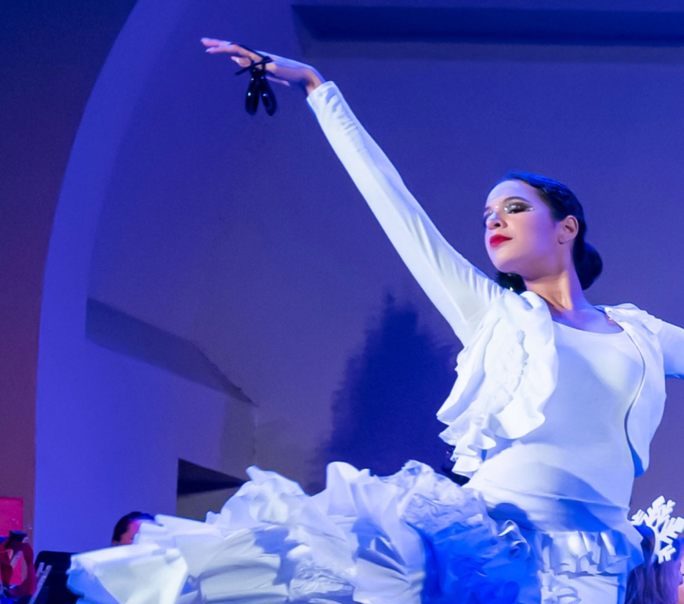














![IN THE SPOTLIGHT: Junior Zalie Mann performs “I Love to Cry at Weddings,” an ensemble piece from the fall musical Sweet Charity, to prospective students during the Fine Arts Showcase on Wednesday, Nov. 8. The showcase is a compilation of performances and demonstrations from each fine arts strand offered at McCallum. This show is put on so that prospective students can see if they are interested in joining an academy or major.
Sweet Charity originally ran the weekends of Sept. 28 and Oct. 8, but made a comeback for the Fine Arts Showcase.
“[Being at the front in the spotlight] is my favorite part of the whole dance, so I was super happy to be on stage performing and smiling at the audience,” Mann said.
Mann performed in both the musical theatre performance and dance excerpt “Ethereal,” a contemporary piece choreographed by the new dance director Terrance Carson, in the showcase. With also being a dance ambassador, Mann got to talk about what MAC dance is, her experience and answer any questions the aspiring arts majors and their parents may have.
Caption by Maya Tackett.](https://bestofsno.com/wp-content/uploads/2024/02/53321803427_47cd17fe70_o-1-1200x800.jpg)
![SPREADING THE JOY: Sophomore Chim Becker poses with sophomores Cozbi Sims and Lou Davidson while manning a table at the Hispanic Heritage treat day during lunch of Sept 28. Becker is a part of the students of color alliance, who put together the activity to raise money for their club.
“It [the stand] was really fun because McCallum has a lot of latino kids,” Becker said. “And I think it was nice that I could share the stuff that I usually just have at home with people who have never tried it before.”
Becker recognizes the importance of celebrating Hispanic heritage at Mac.
“I think its important to celebrate,” Becker said. “Because our culture is awesome and super cool, and everybody should be able to learn about other cultures of the world.”
Caption by JoJo Barnard.](https://bestofsno.com/wp-content/uploads/2024/01/53221601352_4127a81c41_o-1200x675.jpg)




